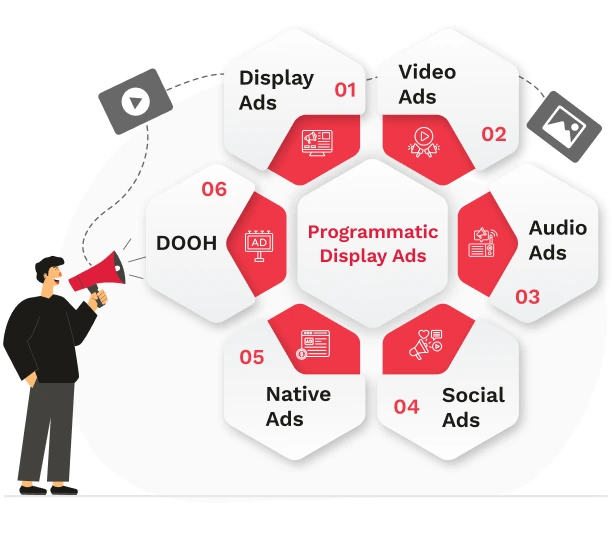
Why Choose Programmatic Display Advertising?
Programmatic Advertising is like advertising on caffeine. Using data and smart algorithms, it replaces manual advertising with automated media buying and real-time ad placement. The key benefits include:
Increased Ad Efficiency
Save time and cost with real-time bidding on lucrative ad spaces.
Right Audience, Right Time
Precision-targeting with filters like location, browsing history, and more.
Omni-Channel Advertising
Embed ads across the best programmatic advertising platforms.
Webential’s Programmatic Advertising Services
As a leading Programmatic Advertising agency, our in-house ad specialists offer the full suite of services needed to deliver big wins in the least amount of time. Explore our services below:
End-to-end Media Planning
With our Programmatic Marketing team in your corner, your ads always reach the most impactful platforms. We evaluate which DSPs (demand side platforms) are best suited for your brand, build custom URL whitelists, and manage campaigns across thousands of publishers and platforms with a centralised dashboard.
Custom Audience Building
We analyse first, second, and third-party data using advanced analytics tools, and derive AI-powered insights from Data Management Platforms (DMPs) to craft custom buyer personas of your ideal audience. These include their online habits, content preferences, and key factors like location, age, gender, and more.
Click-Worthy Creatives
Our Programmatic ad experts work in perfect sync with our creative team to craft ads that balance striking visual appeal with impactful messaging. From standout banners to high-converting videos, we develop a variety of ad formats and sizes tailored to captivate and convert your target and lookalike audiences.
Agile Campaign Management
Webential delivers high-performing ads to the best programmatic advertising platforms, continuously adapting to industry trends, user needs, and competitor strategies. Through real-time bidding (RTB) and budget optimisation, we ensure you only pay for impressions that deliver the highest ROI on your ad spend.
Dynamic Remarketing
Our Programmatic Advertising team uses advanced tools to identify high-interest audiences who’ve previously engaged with your brand through your website or app. We then launch highly personalised remarketing ads, such as ads specifically targeting users who viewed your products but didn’t make a purchase.
Tracking and Optimising Conversion
Webential believes in leveraging data for success. We continuously refine every ad element–from text to visual–by performing rigorous A/B testing to see what brings the highest return on your ad spend (ROAS). Using AI, we repeat this for each segment of your target audience, without any delays or added costs.
Why Does Your Business Need Programmatic Advertising?
Programmatic Display Advertising is a highly scalable advertising engine that enables massive reach, immediate visibility, dynamic optimisation of creatives and budgets, and pinpointed audience targeting for maximum conversion.

Highly Precise Targeting
Display ads only to audiences with the highest chances of making a purchase. Perform specific targeting by automatically filtering audiences based on location, age, gender, browsing history, time of day, content preferences, shopping habits, and more.

Superior Ad Efficiency
Programmatic Advertising enables superior efficiencies by infusing data-driven automation at every stage–including real-time auctioning of ad spaces, dynamic audience building, and optimising the placement and style of ads for effective conversion.

Transparency and Accountability
Programmatic Marketing offers complete campaign visibility. On a single, centralised dashboard, businesses can see the sites on which their ads are displayed, the type of audience viewing their ads, and what return they are getting on their investment.

Ideal for All Businesses
All businesses, including small and medium-sized enterprises, can leverage Programmatic ads without worrying about cost overruns. By placing a monetary ceiling on their campaign, they can easily prevent overspending while also making each dollar count.

Accurate, Real-time Data
Instant data, immediate insights, and real-time decisions–that’s the promise of Programmatic Display Advertising! Unlike manual campaigns which are refined based on stale data, Programmatic ads achieve an extraordinary level of accuracy and agility.
Why Choose Webential’s Programmatic Advertising Services?
Looking for the perfect blend of experience, technical expertise, creative excellence, and transparency? Find it right here at Webential. Trust us with your Programmatic Advertising and see results from day one!
Demonstrated Track Record
With 17+ years of experience and hundreds of satisfied clients, we have what it takes to overcome key advertising challenges and ensure optimum results.
Competent and Proficient Team
We are home to talented ad specialists, designers, and copywriting professionals–all in-house. With us, your programmatic ads will be in the best hands.
Advanced Tools and Technology
We leverage cutting-edge analytics tools, high-end algorithms, and modern AI capabilities to help you reach your advertising goals faster and at lower costs.
Transparency and Accountability
No lies, no bluff–ever. We hide nothing. Our clients receive timely, detailed, and complete reports on the actual progress of their Programmatic Ad campaigns.
Relentless Conversion Focus
Ads that don’t convert mean nothing to you–or us. Hence, we analyse real-time data to continuously refine ad placements and messaging for higher conversion.
Authenticating Display Inventory
We select our publishers and SSPs (supply-side platforms) cautiously. We insist on increased transparency with each buy for a 360° view of the current supply.

Join Forces With One of the Best Programmatic Advertising Agencies!
Programmatic Advertising can give your brand the edge it deserves–but only with the right partner. That’s where we come in. Contact us to discover how our perfect mix of strategy and execution can help your business grow!
Is Programmatic Advertising the Right Strategy for Your Business?
Know the answer by booking a FREE consultation with our experts!
Frequently Asked Questions
What are the different types of Programmatic Advertising?
Programmatic advertising is an automated way of buying and selling ad space, and there are different methods to purchase this inventory:
- Real-Time Bidding (RTB): In RTB, advertisers bid on ad space in real time. When a user visits a webpage, the available ad space is instantly auctioned. Advertisers place bids through a Demand-Side Platform (DSP), and the highest bidder wins the spot to display their ad. RTB offers higher flexibility and better targeting, as ads are delivered to the right audience at the right time.
- Private Marketplace (PMP): PMP is a more exclusive, invite-only auction where advertisers can bid on premium inventory before it becomes available in an open RTB auction. With PMP, programmatic advertising agencies get access to high-quality ad spaces that are not widely available to everyone, ensuring a more controlled and secure environment. However, it comes at a higher cost for better-quality inventory.
- Programmatic Direct: This method allows advertisers to buy ad space at a fixed price, without participating in an auction. It’s ideal for campaigns that need guaranteed ad placements and predictable pricing, though it offers less flexibility compared to RTB and PMP.
| Programmatic Advertising Strategy | Ideal For: |
|---|---|
| RTB (Real-Time Bidding) | Campaigns focusing on flexibility and data-driven targeting |
| PMP (Private Marketplace) | Campaigns that need premium ad spaces and more control |
| Programmatic Direct | Campaigns that prioritise predictability and guaranteed placements |
What is the minimum advertising budget required for Programmatic Advertising?
Programmatic Advertising is highly flexible and allows for campaigns of all sizes. The minimum budget varies, depending on several factors, including audience targeting, quality of the ad space, and more. Typically, programmatic advertising is sold by publishers on a CPM (cost per mile) model, which refers to the cost per 1,000 ad impressions.
Key considerations for the ad budget include:
- Audience and Reach: Broader targeting will require a larger budget, while niche or location-based targeting can reduce costs.
- Ad Formats and Placements: More complex formats like video ads cost more than simpler formats like banners. Premium placements on high-traffic websites or apps also come at a higher price.
- Campaign Duration: Longer campaigns or frequent ad delivery require more budget. However, programmatic display allows for flexibility, like frequency capping, to avoid overspending on impressions.
- Data and Optimisation: Effective use of data can lower spend by targeting high-conversion users.
What is an Ad Exchange? How does it work?
An Ad Exchange is an online marketplace for digital ads where publishers (who own websites, apps, or other media) sell space for ads, and programmatic advertising agencies (like Webential) bid to buy that space in real time. It’s the key enabler for programmatic advertising, ensuring your ads reach the right audience at the right time with little or no human intervention.
How It Works
- Inventory Listing: Publishers list their ad space on the ad exchange.
- Real-time Bidding: Advertisers use a Demand-Side Platform (DSP) to bid on ad spaces automatically. The bids happen in real time and are based on factors like audience relevance, location, and browsing habits.
- Real-Time Auction: The ad exchange runs a real-time auction and decides the winner based on the bid amount and the relevance of the ad.
- Ad Delivery: The winning ad is displayed to the target audience within seconds.
Some popular ad exchanges for programmatic display advertising include:
- Google Ad Exchange
- OpenX
- PubMatic
- Xandr (AppNexus)
How does an SSP differ from a DSP?
Supply Side Platforms(SSPs) are designed to sell ad spaces, while Demand Side Platforms (DSPs) are built for buying ad spaces. While they work hand in hand, their roles are distinct, each serving a critical function for programmatic advertising.
Ad publishers (like website/app owners) use SSPs to get the best price for their ad inventory by making it possible for multiple advertisers to bid for it. The SSP, which integrates with various programmatic ad exchanges, give publishers control over their pricing. They can also choose what types of ads they want to show and decide which advertisers can bid.
On the other hand, advertising agencies leverage DSPs to manage their ad campaigns, set ad budgets, and bid for ad spaces in real time. DSPs make it possible to target very specific audiences with programmatic marketing while optimising budget utilisation, ensuring that advertisers get the best return on their advertising spend (ROAS).
What is the difference between re-marketing and re-targeting?
Re-marketing and re-targeting are conversion strategies used to re-engage audiences who showed some interest in your products/services in the past but need more persuasion. Both usually focus on reconnecting with people who have already interacted with your brand. These could be visitors to your website, users of your app, users who left items in their shopping cart but didn’t complete a purchase, or even those who have searched for your products/services online.
Key Differences:
- Re-marketing often uses email campaigns and “push notifications” to remind users about your products or services.
- Re-targeting, on the other hand, uses cookies or pixel tracking to target users by showing them ads about your products/services when they visit other platforms or websites.
What is DoubleClick?
DoubleClick, now part of the Google Marketing Platform, simplifies and optimises programmatic advertising for both advertisers and publishers, offering them the tools they need for programmatic display success. These include the following:
For Advertisers:
- Campaign Optimisation: Helps build and refine campaigns to improve key metrics like click-through rate (CTR), return on ad spend (ROAS), and cost per acquisition (CPA).
- Audience Targeting: Provides critical ad controls to ensure that programmatic ads reach the right users, increasing relevance and performance.
- Multi-Channel Strategy: Helps integrate programmatic advertising campaigns across search, display, video, and mobile to get the most out of every ad dollar.
For Publishers:
- Maximising Revenue: Helps with pricing and managing programmatic ad inventory to attract quality advertisers and boost ad revenue.
- Ad Quality Control: Helps ensure the ads shown on a site or app are relevant to the audience.
- Technical Optimisation: Helps with configuring Google Ads Manager like managing ad tags and tracking analytics.

